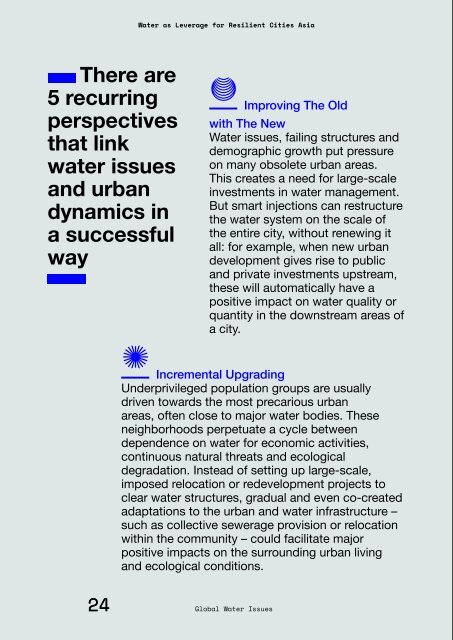Water as Leverage- Setting the scene for a call for action
- No tags were found...
You also want an ePaper? Increase the reach of your titles
YUMPU automatically turns print PDFs into web optimized ePapers that Google loves.
<strong>Water</strong> <strong>as</strong> <strong>Leverage</strong> <strong>for</strong> Resilient Cities Asia<br />
<strong>Setting</strong> <strong>the</strong> Scene <strong>for</strong> a Call <strong>for</strong> Action<br />
Content<br />
There are<br />
5 recurring<br />
perspectives<br />
that link<br />
water issues<br />
and urban<br />
dynamics in<br />
a successful<br />
way<br />
Improving The Old<br />
with The New<br />
<strong>Water</strong> issues, failing structures and<br />
demographic growth put pressure<br />
on many obsolete urban are<strong>as</strong>.<br />
This creates a need <strong>for</strong> large-scale<br />
investments in water management.<br />
But smart injections can restructure<br />
<strong>the</strong> water system on <strong>the</strong> scale of<br />
<strong>the</strong> entire city, without renewing it<br />
all: <strong>for</strong> example, when new urban<br />
development gives rise to public<br />
and private investments upstream,<br />
<strong>the</strong>se will automati<strong>call</strong>y have a<br />
positive impact on water quality or<br />
quantity in <strong>the</strong> downstream are<strong>as</strong> of<br />
a city.<br />
Incremental Upgrading<br />
Underprivileged population groups are usually<br />
driven towards <strong>the</strong> most precarious urban<br />
are<strong>as</strong>, often close to major water bodies. These<br />
neighborhoods perpetuate a cycle between<br />
dependence on water <strong>for</strong> economic activities,<br />
continuous natural threats and ecological<br />
degradation. Instead of setting up large-scale,<br />
imposed relocation or redevelopment projects to<br />
clear water structures, gradual and even co-created<br />
adaptations to <strong>the</strong> urban and water infr<strong>as</strong>tructure –<br />
such <strong>as</strong> collective sewerage provision or relocation<br />
within <strong>the</strong> community – could facilitate major<br />
positive impacts on <strong>the</strong> surrounding urban living<br />
and ecological conditions.<br />
History is The Future<br />
Urban settlements in lowlying<br />
are<strong>as</strong> or around complex<br />
river systems usually had to<br />
develop a secure system of<br />
me<strong>as</strong>ures <strong>for</strong> water protection<br />
or storage throughout history.<br />
Due to population pressure,<br />
however, <strong>the</strong>se old inventive<br />
water structures are often<br />
incre<strong>as</strong>ingly abandoned,<br />
disused or considered only <strong>as</strong><br />
cultural heritage.<br />
(Re)structuring current<br />
and future urbanization by<br />
recovering this historical water<br />
system and reactivating it with<br />
contemporary techniques can<br />
contribute to <strong>the</strong> resilience<br />
<strong>the</strong>se water cities once had.<br />
Living with <strong>Water</strong><br />
Urbanization in low-lying are<strong>as</strong><br />
such <strong>as</strong> wetlands or delt<strong>as</strong><br />
h<strong>as</strong> to deal with water issues<br />
in an almost amphibious way.<br />
Periods of too much or too<br />
little water result in a complex<br />
multi-dimensional paradox of<br />
excess and shortage, usually<br />
leading to heavy drainage<br />
or aquifer overexploitation,<br />
setting in motion a<br />
rollerco<strong>as</strong>ter of problems of<br />
<strong>the</strong>ir own. Integrated, systemic<br />
water sensitivity strategies and<br />
typologies that store, delay,<br />
retain or re-use <strong>the</strong> available<br />
water can help to unravel <strong>the</strong><br />
paradox and balance <strong>the</strong> city’s<br />
water issues.<br />
Adapt to Mitigate<br />
<strong>Water</strong> problems in urbanized are<strong>as</strong> are usually<br />
mitigated: protection me<strong>as</strong>ures prevent <strong>the</strong> worst<br />
damage and keep <strong>the</strong> city’s livelihood safe. But<br />
we could also adapt to <strong>the</strong> problems we face by<br />
generating solutions that start from <strong>the</strong> systemic<br />
logic of changing dynamics – such <strong>as</strong> sea level rise,<br />
storm incre<strong>as</strong>e or fl<strong>as</strong>h floods. Literally creating<br />
room <strong>for</strong> water bodies to flood safely could also<br />
generate or streng<strong>the</strong>n adaptive economies and<br />
improve <strong>the</strong> quality of <strong>the</strong> immediate urbanized<br />
surroundings.<br />
24<br />
Global <strong>Water</strong> Issues<br />
PART 1 / From Global <strong>Water</strong> Issues to a Call <strong>for</strong> Action<br />
25


















